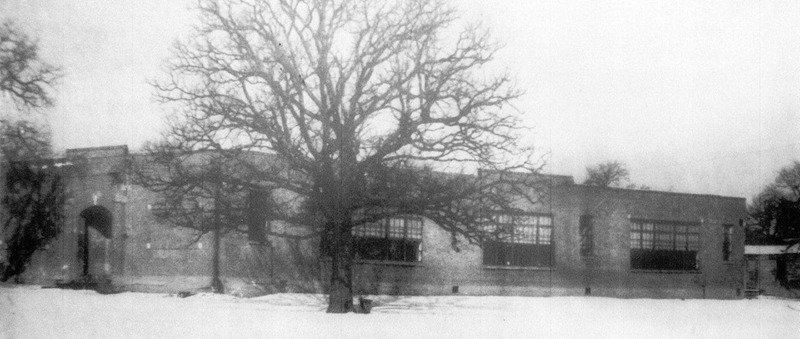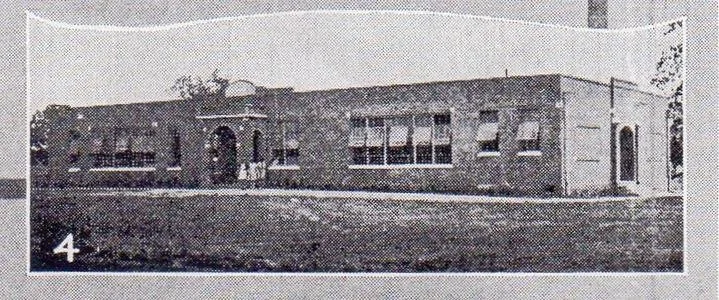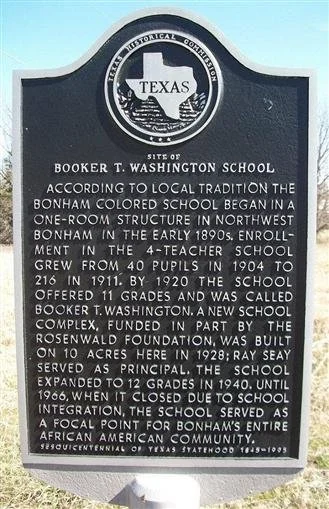Booker T. Washington School
Marker Text:
According to local tradition the Bonham colored school began in a one-room structure in northwest Bonham in the early 1890s. Enrollment in the 4-teacher school grew from 40 pupils in 1904 to 216 in 1911. By 1920 the school offered 11 grades and was called Booker T. Washington. A new school complex, funded in part by the Rosenwald Foundation, was built on 10 acres here in 1928; Ray Seay served as principal. The school expanded to 12 grades in 1940, until 1966, when it closed due to school integration. The school served as a focal point for Bonham's entire African American community.
Location: Katy Blvd. & E. 5th Street, Bonham
See the 1948 Washington High School yearbook and the 1963 Washington High School yearbook. We believe these are the only 2 yearbooks for Booker T. Washington School. If you have additional yearbooks or photos, please contact us.
A History of Booker T. Washington School
By Tom Scott
Bonham Daily Favorite, July 31, 1994
This brief story of the Bonham Black Schools was written so that a history of the schools would exist. The schools produced some great citizens who therefore should be remembered.
Part of the difficulty in dealing with the history of the Black schools in Bonham results from the absence of official school records from the founding of the public school system in 1890 until 1904. The so-called first record book of the Bonham school boards in this time period no longer exists and its fate is unknown.
In order to compensate for this lack of official proceedings it has been necessary to rely on the memories of those persons who were products of the school system. In this effort special thanks are given to Mr. Willie Ross, Mrs. Noble S. Smith, Mrs. Noble Chapman, Mrs. Manella M. McKee and Mrs. Hattie Nichols.
The first school for negro students was called the Bonham Colored School. it is believes to have been built in the late 1800's, but whether is was privately operated or a product of the city school system is unknown.
The school, a one room frame structure located in northwest Bonham on Franklin Street. The staff of two consisted of teacher and principal Professor Higgs who was assisted by a Mrs. Crawford.
This building was destroyed by fire probably about 1896. In that year a new site was purchased in east Bonham. The deed of record is the first evidence that the school was probably established as a part of the city school system.
Recorded in Deed Book 62, page 565 of the Fannin County deed records is the purchase "by the trustees of the Public School of the City of Bonham" for a sum of $200 a part of Block 17A of the Bailey Inglish Survey from the sellers Berry Stone and William Johnson. October 24, 1896.
The school was staffed by Principal Thurston, Mrs. V. A. Johnson Bradford and Mrs. Eliza Bennett, first grade teachers, Mrs. Viola Johnson, second grade teacher, and a Mrs. Crumpton, fourth grade. It is possible that these were the only grades required at that time or it seems certain that these teachers were responsible for more than one grade. As will be seen from later records, no more than four teachers were ever employed for a school year.
With the beginnings of Bonham Public School record Book #2 we have a limited amount of information concerning the operation of this school. Scholastic reports for all the Bonham schools were reported in the local newspaper, The Bonham Daily Favorite. These reports were filed as a matter record in the act of the Bonham School board. A sampling of these reports give some idea s to the size of this school. In November, 1904 40 students were reported enrolled. By December the number had more than quadrupled to 179. It has been suggested that this sudden upsurge was the result of many of the black children returning to school after an autumn spent picking cotton in the fields of Fannin County.
A year later, January 1905 the enrollment was 227, but a decline occurred in 1909 with an enrollment of only 166. Evidently a problem was developing with the attendance. At the February 1911 meeting of the school board, Principal J. H. Stewart was commended for his efforts in enforcing the attendance and punctuality regulations with a resulting increase in enrollment to 150. By the end of 1911, 216 students were enrolled with a 91.5% attendance record.
The early years of the century show that at most only four teachers were employed annually with very little turnover among the staff. The most frequent changes were in the principal's position. Between 1904 and 1920 this position changed about every four years. Among the men filling this charge were J. H. Stewart, H. S> Smith, J. A. Sykes, and S. C. Patton. Mrs. Viola Johnson and Mrs. Wade Johnson remained in their positions for many years joined by a number of different teachers who lasted only one or two years.
During these years the school was structured to provide only nine years of education. By 1920 however, grades ten and eleven were added. Along with the state mandated change in 1940 the twelfth grade was added.
Although nothing in the records indicate when or why, by 1920 the name of the school was changed from Bonham Colored School to Booker T. Washington. However the two names were used interchangeably until the end of the decade.
At the February 21, 1928 meeting of the school board, a previously appointed committee reported that their study indicated the need for the construction of two new school buildings for the system and that the passage of a bond issue to construct the facilities would be needed. On motion of board member Bland Smith the board voted to request the Bonham City Council to call for a bond issue in the amount of $50,000. Late records indicate the election was called for April 14, 1928.
The bond issue passed and at the April 22 meeting the board moved to purchase a ten acre tract of land for the construction site. The board also ordered to received bids for construction of a red brick building.
On May 22 bids were received and opened. The bids were structured not only for new construction but also for razing the old building at the corner of Seventh and the Denison Bonham and New Orleans Railroad road bed. Six bids were received ranging from Wood Brothers high of $16,063.00 to Francis Steger's low bid of $12,900.00. On motion of board member Sid Smith the contract was awarded to Steger.
At that same meeting the budget for the 1928-1929 school year was approved reflecting the evident changes for Washington School. The school's budget was set at $19,301.86 which was t include $1000 for repairs to old furniture, $13,100 for the building and contract, #1400 for furniture, and $300 for other equipment.
On June 15, 1928 the deed for the purchase of the building site was recorded in the deed records of Fannin County. Ten acres of a 36 acre tract Block 9 of the Bailey Inglish survey comprised the site. The land was bordered on the south by U.S. Highway 5, on the west by the rail bed on the D.B. and N.O. Railroad and on the north and east by the remaining portions of the original tract. The land was sold by L.C. Wilson, Jr., administrator of the estate of Lake C. Wilson, Sr. for $1500.
Construction was well underway by the summer of 1928.
In January of 1929, the school board was informed by a letter from G. T. Bludworth of the State department of Education that a grant from the Julius Rosenwald fund would be awarded to Washington School with $1000 for any expense on building and equipping the building, $200 for the library, $200 for additional equipment for the home ec department and $400 to assist in the erection of a teacher's home. (Note: This teachers home was discussed by the board over the next several months but evidently no action was taken on it.)
At that same meeting after discussion with the contractor over the appearance of a large crack in one wall of the building, a satisfactory arrangement was reached for acceptable repair and the board accepted the building. The records do not indicate whether the building was occupied immediately or not. The first official record was the opening of the school in October 1929 with Ray Seay as Principal, and faculty Mrs. Ray Seay, Mrs. Myrtle Johnson, and Virgie Johnson.
Growth of the school after World War II required the addition of two frame classrooms moved to the site from Jones Field, a pilot training base located in Bonham during the war. In 1946 a hanger was moved from the base and converted to a gymnasium on the grounds of the school. A stage was built at one end of the gym by two local men, Earl Johnson and Tony Ballard.
For years the school facility served as a focal point for the entire black community. The annual KP picnic was held on the grounds for many years and community dances were staged in the gymnasium. The student body was always encouraged to participate in a wide variety of extracurricular activities. In sports the school won several district and state honors. The eagle was adopted as the school mascot and the school colors of green and white were always proudly displayed at all events.
Other than those previously listed these men also served in the administration as principal of Washington School: Mr. Butler, Mr. James Seay, Mr. W. J. Taylor, Mr. E. C. Erwin, Mr. J. L. Halford, Mr. M. B. Walton, and Mr. R. E. Carreathers.
The 1960's brought many changes in the education process. Schools consolidated, Federal programs such as Headstart and Title One were instituted. With the changes came the end of a segregated school system. The Class of 1966 was the last to graduate from Booker T. Washington School. The next year the school was closed as the Bonham School District integrated.
The portable buildings were sold from the site and the brick structure razed in the late 1960's. The property was sold in 1967 and is now a commercial site. The oldest living graduate of the Black School System in Bonham is "Uncle" Willie Ross who will celebrate his 107th birthday on September 8, 1994.
Another is Mrs. Noble Stewart Smith who shares with Mr. Ross the distinction of being the oldest graduates. Mrs. Smith's class had thirteen members and was one of the last of the classes to attend only nine years.


